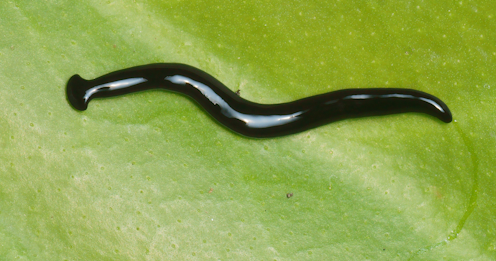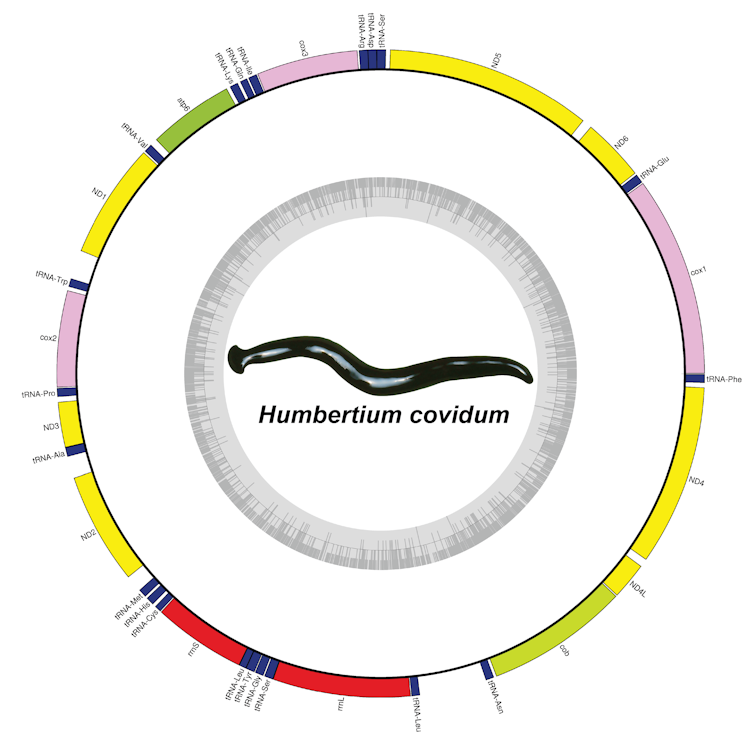
A hundred animal or plant new species are described each year in metropolitan France. In most cases, these are native species, present here for a long time, but which had so far escaped the attention of scientists. In a very different way, we are now reporting the existence of a new species found in France, but which has been introduced, and which is even potentially capable of invading our gardens.
This species is a flatworm, the size of one knuckle of your little finger. The species is elongated, with a broader head, like all hammer-headed flatworms. Its colour is quite extraordinary: totally black, it is reminiscent of “liquid metal”. Its name: Humbertium covidum – we will come back to this name later.
How to tell the species apart?
For about ten years, we have known that flatworms have invaded the gardens of France. Our team thus reported and mapped the invasion by several species: the New Guinea flatworm (Platydemus manokwari), the giant hammerhead worms (especially Bipalium kewense) and the oddly named Obama nungara, which alone has invaded more than 70 departments in France. We have also reported recent invasions overseas.
To give a name to a species, scientists must be convinced that the species is new, and therefore explain how it is different from already known species. In all cases, the shape and colour of the organism must be accurately described. Very often, it is also necessary to precisely describe the sexual organs of the species, which are characteristic and different from other species. This is where a problem arises for flatworms: some species only reproduce asexually, and therefore simply do not have sex organs. One can imagine the problem of how then to differentiate them. This is why we used modern molecular biology techniques to characterise the mitochondrial genomes of these species.
The mitochondrial genome
The mitochondrial genome, abbreviated as mitogenome, is the genetic code that makes the mitochondria work, small organelles that are in their thousands and are the energy powerhouses in all cells. As this mitochondrial genome is present in millions of copies in an animal, it is therefore technically easier – and less expensive – to obtain it than the genome of the nucleus. The mitochondrial genome is circular DNA, about 15,000 nucleotide base pairs long: long enough to give a lot of information, and short enough to be easily obtained.
We therefore obtained the mitochondrial genome of several species of invasive flatworms, such as that of the New Guinea flatworm and hammerhead worms. We used the characteristics of these genomes to differentiate the species found, even if they had no visible sexual characteristics.

The new species in France
We found the new “metallic black” species in two gardens in France, both in the department of Pyrénées-Atlantiques, in communes separated by a hundred kilometres. It is now well known that the department of Pyrénées-Atlantiques is a small paradise for flatworms introduced from all over the world, mainly because of its mild and always somewhat humid climate. In both cases, there were only a few individuals of the black species.
At the beginning of our study, we even wondered if they were not simple black variants of a larger species, Bipalium kewense, also found in these gardens. But close examination of the specimen morphology and genome, and comparison of these with other species, there was no doubt that the black species was different. We then looked in the scientific literature if the species had been described elsewhere, and especially in tropical Asia, which is the main continent of origin of these hammerhead worms. We did find a few reports of animals that look like it, but nothing more.
Also in Italy
Toward the end of 2019, we were warned that a black species was proliferating in a field in Veneto. Hundreds of black worms, very active early in the morning, and very mobile. Other reports were then made of this black worm near Rome. We compared the mitochondrial genome of individuals found in France with that of individuals found in Italy: they were very little different, which shows that they are the same species, which was therefore already present in two countries in Europe.
And so, it was necessary to describe the species, that is to say, to give it a Latin name.
The name of the new species
Assigning a name to a species is an essential and essential key step for any subsequent study. When dealing with potentially invasive species, and which therefore may attract the attention of the legislator, it is even more essential to be able to name them: the laws and decrees use Latin names, because these names guarantee that we correctly designate the right species.
Each Latin species name is binomial, with a genus name and a species name. For the genus name, it is “Humbertium”, simply because the animal has the characters of this genus described in 2001. For the name of the new species, we have chosen “covidum”, a name obviously based on “Covid”, the virus. Why? First, because we started this work in 2020, when our laboratories were in the Covid pandemic regulatory lockdown. Then, as the pandemic progressed, we wanted to name the species to honour of all the victims. And finally, it seemed to us that “covidum” was an appropriate name for an organism capable of invading the world and coming from Asia, like the Covid-19 pandemic itself.
Invasive species
Apart from the description of this single species, what does this discovery of a new species of flatworm in Europe tell us? Above all, that foreign species are constantly invading our regions (the same thing exists elsewhere in the world, with European species invading other continents). Should we blame them and hold them responsible? These species have nothing to do with it, of course. It is humanity that is responsible, and in particular the modern phenomenon of globalisation, by which goods are circulated at a breakneck pace in all directions. A few individuals of a flatworm, who do not realise anything, find themselves crossing the whole world in a few days, probably in the soil of a lot of plants. They arrive in a new environment where their natural enemies are absent, find abundant food, and proliferate. In the case of Humbertium covidum, by analysing the DNA of their prey, we were able to show that the species eats small snails, but it may also consume other prey.
How is this arrival of Humbertium covidum a problem? Because the animal species that live on and in the ground have been in balance with their European environment for a long time, and the arrival of an opportunistic predator can change this balance, and therefore alter the biodiversity of our soils. Altering biodiversity has an ecological cost, and even an economic cost. For example, we can calculate that invasive species reduce agricultural production. The cost of invasive alien species in France is enormous, in the order of hundreds of millions of euros per year.
Humbertium covidum is therefore one more example of an introduced species, which ultimately threatens biodiversity. Hopefully, unlike the virus that gave it its name, it doesn’t take over the world.
Jean-Lou Justine has received funding from the Muséum National d'Histoire Naturelle. He is one of the "Academic Editor" (volunteer) of the scientific journal PeerJ in which this research is published.
Leigh Winsor does not work for, consult, own shares in or receive funding from any company or organisation that would benefit from this article, and has disclosed no relevant affiliations beyond their academic appointment.
This article was originally published on The Conversation. Read the original article.







